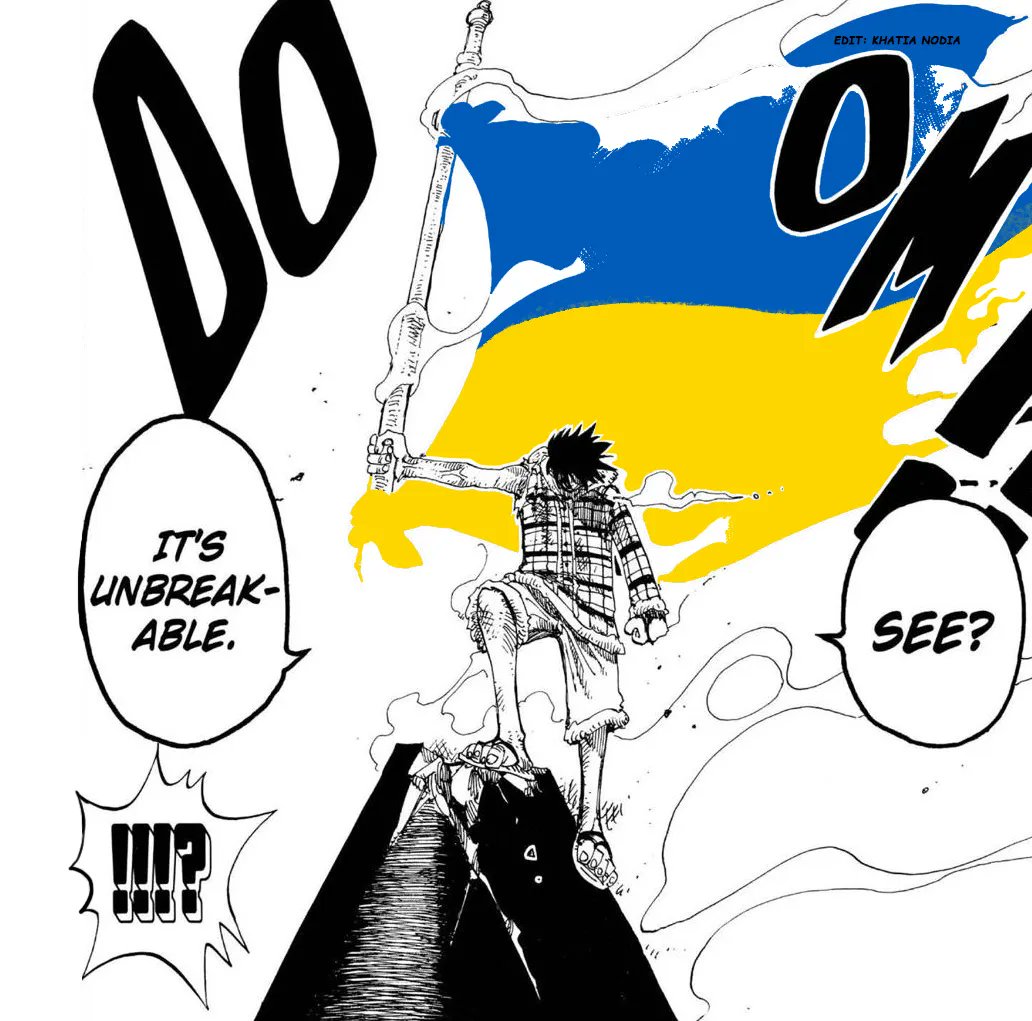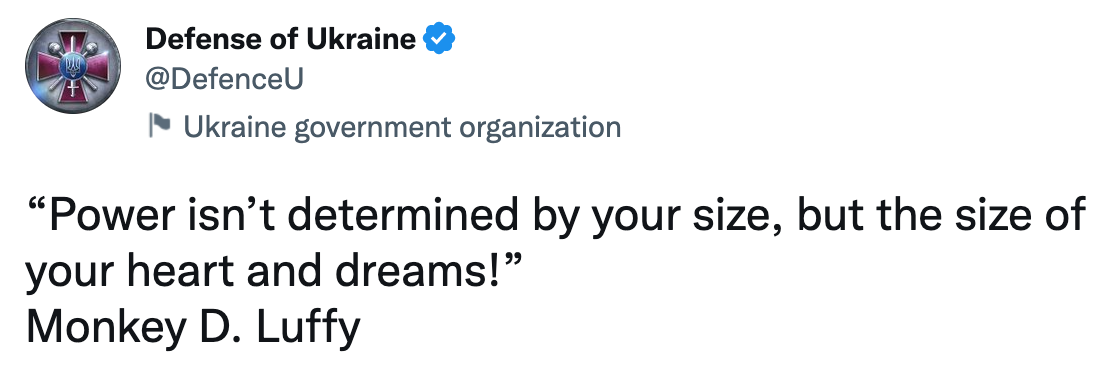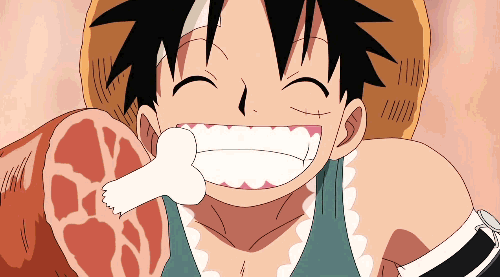Nakamas getting hurt


Nakamas resisting



The Bible already did it. Duh.

You don't know what you would be able to achieve if you were willing to really sacrifice yourself to achieve it. We don't know what would happen, because normal people don't usually don't tend to sacrifice themselves. We are not willing to sacrify to fulfill our dreams.
But in One Piece we are watching precisely this play out. We are seeing a person who is willing to sacrify himself to alarming lenghts. Luffy is a young boy, an orphan, who is willing to sacrify his wellbeing, his life, to achieve a magnificent goal. And we see him transform in the process, and we see him progress towards this goal as a consequence.
It is very easy to remember times in which Luffy put his life in danger to achieve his goal, to defeat an enemy or to protect a friend. We have seen Luffy bleed and sustain deadly injuries so often that it does not surprise us anymore. But you may have not noticed that his willingness to sacrify himself is present from the earliest point of the story.
| Art | Dialogue |
|---|---|
 |
|
 |
|
 | |
 |
When Luffy was a small child, he wanted Shanks to take him with him in his adventures. But Shanks refused, claiming that Luffy was still a child, who was afraid of being harmed, looked cute and drank milk – typically childish things. Luffy knew that his childliness was in the way of his goal. So, in a weirdly ritualistic act, he cut his own face with a knife.
When I say ritualistic I really mean it. He clibs to the top of the mast of the ship, which is the leading section of the ship, quite literally, and also a high spot from where he can be seen by everyone. And right there, gets a knife out, and inject it into his face.
This seems barbaric. Everyone seems to think so, even these tough pirates are apalled. And you may look at it and think that it is stupid, barbaric or dumb. But it's not.
If you look back in history, most cultures had some form or other of ritualistic sacrifice. You see this in the Bible, as early as Abraham. Abraham was constanly making sacrifices. Before embarking on a journey or doing something important, he would grab a baby lamb or something valuable, and he would sacrifice it. This may seem, again: barbaric, primitive and supersticious. But think about it. Even if you think about it as a modern person, you have to admit that the act of sacrificing something may have some dramatic effect on your own mind. Imagine yourself going to a field, grabbing a newborn lamb, and cutting its throat. And think that in the times of Abraham a lamb was something very valuable, so instead of eating it, he would burn it. It would be like buying an iPhone in today's world, and burning it. It is a way of indicating to yourself that you are serious about something. I don't really have another example. Which shows that nowadays we don't seem to have rituals of seriousness.
Imagine that you are serious about a goal. For instance, you want to get into shape, because you are unhappy with your fat ass. And you sign up at a gym. Okay, now imagine that you also grab a baby lamb, kill it with your own blody hands, and burn an iPad in a fire, as a token of your commitment. Imagine that. Are you willing to do that? I don't think so. So maybe you are not serious enough about getting in shape. So it's not so obvious that we are actually serious about anything. But imagine if you did slay the lamb: wouldn't the memory of killing the lamb stick with you and remind you about your commitment? I think it would. So maybe Abraham and all those people were not stupid and primitive. Maybe they knew something that we don't. And so did Luffy when he was 6 years old.
Is Luffy commited to his dream of becoming the king of pirates? You bet you ass he is. How do you know? Because he sacrifices himself over and over again to fulfill it. His commitment is derived from his sacrifice. They are the same thing. Indeed, the story of One Piece one of sacrifice in pursue of one's dreams. And this is true from the very begining, when Luffy is 6 years old and put a knife in his cute little face.
And I think that it is truly beautiful that in One Piece the ideas of sacrifice and commitment are embeded into the narrative, at the level of dramatic action. Instead of abstract explanations, Luffy is acting out the idea of sacrifice and commitment, from the very begining of the story. And it looks simple, but the fundamental concepcion is so profound. And it's truly breathtaking when you understand what message is trying to be conveyed.
You cannot be sure of your commitment without sacrifice. Well, actually, achieving a great goal almost always requires self sacrifice. And what do you have to sacrifice to achieve a great goal? That which is currently stopping you from achieving your goals. And specially the things that difficult to sacrify. In Luffy's case, his child-like attibutes: his fear of getting harm, his child-like cuteness; which are valuable things, that are getting in the way. And by sacrificing these valuable things, he transcends them, willinglly, empowering his commitment, which in turn empowers him.
So, am I advising 6 year old kids to take a knife and injure their faces? Well, maybe not. Depends on why they would do it. But what I'm saying, and what Luffy represents, is that if you are going to embark on an adventure to fulwill your dream, you are going to undergo some radical transformations. You will have to change things about yourself. And transforming yourself is a form of self harm. Psychologically speaking, you kill a part of yourself. You kill the part of yourself that is stopping you from fulfilling your dream.
So self-transformation is always sacrificial. You are voluntaryly sacrificing a part of yourself. So the call to fulfilling your dream is also the call to a series of deaths and rebirths, that move you closer and closer to your goal. And that is what the One Piece is calling Luffy to do, right in the first volume of the story. Showing you that Luffy is all about commitment, and zero about excuses.
And I think that it also becomes obvious, through Luffy, that the willingness to sacrifice oneself does not mean, at all, having suicidal tendencies. Luffy is clearly not depressed. If anything, it's the opposite. And this is a weird phenomena, right? If I didn't have the example of Luffy, it would be difficult for me to explain the difference between suicidal tendencies, versus willingness to sacrifice oneself.
But when you look at Luffy, you see very clearly what is happening. He is so full of will to live, he is so commited to his goal, that he is willing to sustain harm. He wants to live so much, that he is willing to kill certain parts of himself. This is nothing, absolutely nothing to do with people who are depresses and are willing to kill themselves.
Or maybe it does? Now that I think about it. Maybe in a certain way, altough I don't think this is the case. Think about this: imagine if you are not able to diferentiate the parts of you that are holding you down. You don't know what you should sacrify. You don't have the clarity to diagnose your own problem, or maybe you don't have clarity about your goals and your dreams. And without the clarity, without knowing what you want to do, a which parts of you are holding you down, maybe killing the whole thing may be a possible answer. But I really don't think that this is what happens in the mind of most people who consider killing themselves, but maybe it does.
Crucifixion is undoubtedly a powerful symbol. It's a ritual that non of us has experienced, and yet we all know.
Crucifixion is very central to the Christian faith. it's actually the very symbol of the Chrisyiam faith. But I would argue that it's even more central in One Piece, or at least it is more recurring.
And most crucially, the astonishing thing is that it always seems to represent the same thing.
Crucifixion is a form of punishment through torture of suffering and public display of the ordeal.
As with most form of torture, is very clear why the experience is unpleasant. I find it hard to even describe the process without putting a facial expression of pain.
But there is another element that seems arbitrary, and yet it is recurrent in stories about crucifixion. It's the fact that the person being crucified is innocent. This comes in many forms, one of them being that the person being crucified chose to withstand that punishment in order to protect someone or something else.
So the image of a crucifixion is appalling, and also somewhat inspiring, because it portraits the goodness of a person, as well as the terrible suffering that they are withstanding due to their suffering.
As early as the first volume of One Piece, we encounter a character being crucified.
 |  |
Yes, absolutely. In fact, it's based on a lot of true stories.
You all went to school as a child. All of you. Every day, you woke up, went to school, took clases, played games, dealt with teachers and did a bunch of things. So imagine: I pick one of those days, literally, one of the many days that you went to school. Imagine any particular day in which specific things happened. If I described that day, minute by minute, would it be the best way of describing the truth of going to school? No. It's not. It's just one day. It would be extremely boring. Because most of the day is filled with the teacher talking, you waiting in line, and doing insubstantial things. It would be the best way of describing that day, but it's a poor way to explain the experience of going to school.
Check out more information in The Necessity For Stories.
But now imagine if you analysed every day that you went to school and you extracted the most important things that happened across all days. You pick the things that had the biggest impact over you. Maybe a day in which you told a girl that you liked her, or the day in which you got caught doing a bad thing, maybe your birthday, or the day when you found a frog. And then we do that with each and every person of this room. We find the things that were important for most of us, across all of the days that we went to school. You all had different childhoods, but there maybe be lots of things that were common and that you remember specially. Maybe playing with snow and throwing snow balls. Maybe playing hide and seek with your best friend.
Now we make up a day in school that includes all those elements. This would be a story about one day in school that didn't really happen, but that includes all the elements that truly represent going to school, for everyone one of us. We make up a day that never happened, in which you found a frog, played hide and seek and told a girl that you liked her.
What I'm saying is that the fictional story is a more truthful representation of the reality of the actual experience of going to school. It's the condensed and distilled story of what constituted going to school every day. You take the essence, you distill it, and create a representation. That's a meta truth.
So, again, what you do is you extract the essence of many truths, and build up a story that carries the maximum exponents of those truths. That's a meta truth. Is the most representative representation.
We all know that Luffy and the straw hat pirates are not, technically, factually navigating the sea in a boat, living adventures. But their story is extremely insightful. The story is a carrier of truths, more so than what's happening to any boat that's in the ocean right now. Right? The story of the straw hats carries more insights about how to behave with your friends, how to pursue dreams, how to deal with failure... more so than what is happening in any of the boats that are currently, as we speak, in the ocean.
And it's in this sense that I would argue that the story of the straw hats is very real, it's very truthful - because it contains the most important and impacting elements of our day to day, and presents them in the extreme and most meaningful way possible.
A good way of looking at it is that the stories are erroneous in detail, and right in pattern. So the pattern that they represent is very accurately described in the story. Actually, the pattern is more accurately described in the story than in any actual and specific day. So the story is erroneous in detail, but right in pattern.
The pattern is so abstract, it's so meta, that it goes beyond any instantiation, it's more correct, more useful, more truthful than any particular occurrence of the pattern. And if the pattern is well extracted, it's useful beyond the detail. For instance, even if you grew-up in a place where it never snows, and I tell you how I had fun in a snow ball fight with my best friend, you can still understand how that totally represents the pattern of going to school; you can translate that to the specific details in your instantiation of the pattern.
It's easy to see how meta truths help you solve the problem of how to behave in the world, or what decisions to make in your personal life. Because you need to understand patterns of behaviour. And patters are encoded in stories. So you need to predict what would happen if you do that, or the other, and you can only predict that I've you've observed the pattern. And the pattern is transmitted through the story. And you want the most effective pattern, and that's the one of a meta story.
